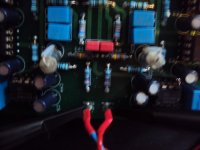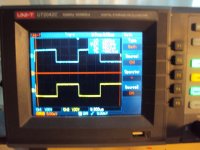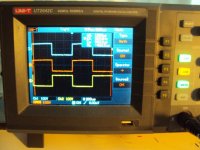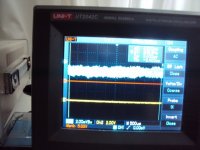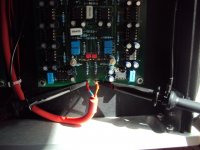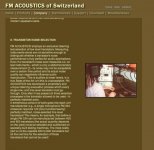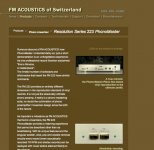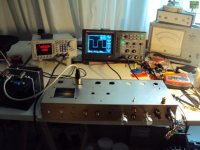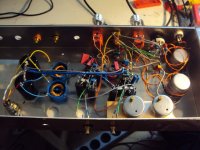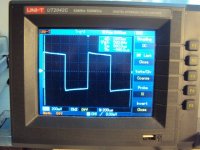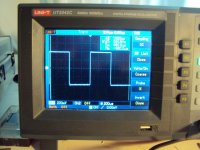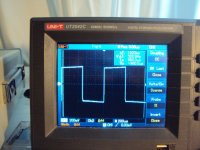LM317,337 pre regulator and transformer in external box, Jung-Didden type super regulator in the main box for both channels, RC-filter separate for both channels, shunt regulator, decoupling, in order of appearance. Consequent star earthing. There will be a double mono version with two pre regulators, two super regulators, in 4 boxes but the version presented here has already very good channel separation. I will show measurements of the differential RIAA and channel separation.
Looking very good indeed.Here is the difference and the sum.
I visited a lot of people last week. I set up this Phono Stage in 5 systems and it sound very good under a variety of circumstances. Feedback differential RIAA works if done right. Nobody was complaining about a loss of resolution. Quite the contrary. When i switched to balanced input ( unfortunately i could not demonstrate the balanced output because all 5 systems had unbalanced pre- and power amps ) people where amazed by the gain of openness and expansion of the soundstage. For the ultimate in hum rejection balanced is the way to go. The only disadvantage i can see is 3dB more hiss with the same amount of input devices in an unbalanced stage. In praxis that boils down to less because the impedance of the cartridge adds as a noise source.
The Rauschfrei has a Johnson noise of 10 Ohm. My best unbalanced stages reach 5 Ohm.
My Titan has around 6 Ohm so we end at 16 Ohm against 11 Ohm.
The Rauschfrei has a Johnson noise of 10 Ohm. My best unbalanced stages reach 5 Ohm.
My Titan has around 6 Ohm so we end at 16 Ohm against 11 Ohm.
Are you following this ? http://www.diyaudio.com/forums/power-supplies/192625-sslv1-1-builds-fairytales-59.html#post2751686
There are even better designs around
There are even better designs around
From time to time. Sure, i make a ( maybe ) better phono stage with much more alaborate PSU too.
The Opus Magnum. I have published some pictures here when it was the Magnum Opus.
For the Suesskind Rauschfrei i doubt that an even more sofisticated PSU would make an audible diffence except the total double mono version because the circuit has tremendoes PSU rejection in itself. It has much less hum then my tube power amp. The hiss has a very benign soft qualtity. When i crank the system full there is just some audible hiis in the listening space. Muisc is so loud under this conditions that the speakers crash to the end stops with horrible noise in no time.
The Opus Magnum. I have published some pictures here when it was the Magnum Opus.
For the Suesskind Rauschfrei i doubt that an even more sofisticated PSU would make an audible diffence except the total double mono version because the circuit has tremendoes PSU rejection in itself. It has much less hum then my tube power amp. The hiss has a very benign soft qualtity. When i crank the system full there is just some audible hiis in the listening space. Muisc is so loud under this conditions that the speakers crash to the end stops with horrible noise in no time.
I am designing an inductive phono stage for a well known german audio personality that also has a distribution company. It has some interesting features. I was able to reduce the frequency shaping components to simple multiplications. So that way i can leave the inductor and cap that are responsible for response shaping constant and vary only the series resistor when i want other EQ´s then the RIAA curve. Instead of fixed resistors i am using pot meters. High quality wire wound in the bass and conductive plastic in the treble.
That way i can vary the time constants with near infinite resolution. I have already installed the bass "tone control" and it gives me a range of ca. plus - minus 4.5dB at 20Hz. I can use this not only to copy other time constants then 3180 usec but it also works
as a suple tone control if the record sounds too thin or too fat. The treble control will work over a range of 10 uses to 110 usec.
The stage has a transformer coupled MC input and an MM input. I may add a second silicon based MC input. The output can swing 100mA so a headphone can be connected.
Gain is enough to make a preamp redundant and i may add an alternative tube output stage. I build the 3D point to point wiring prototype into a guitar amp case.
That way i can vary the time constants with near infinite resolution. I have already installed the bass "tone control" and it gives me a range of ca. plus - minus 4.5dB at 20Hz. I can use this not only to copy other time constants then 3180 usec but it also works
as a suple tone control if the record sounds too thin or too fat. The treble control will work over a range of 10 uses to 110 usec.
The stage has a transformer coupled MC input and an MM input. I may add a second silicon based MC input. The output can swing 100mA so a headphone can be connected.
Gain is enough to make a preamp redundant and i may add an alternative tube output stage. I build the 3D point to point wiring prototype into a guitar amp case.
Attachments
They are specially made for me by Sowter with 2% tolerance. The are wound on Mu-Metal and are in Mu-Metal cases. This is important for least amount of distortion and hum pickup. They are very expensive. Around 100,- pound a piece including tax and shipping. The best i could find after a lot of frustration to build something myself.
